Contents
Introduction
The crypto economy has grown significantly, leading to sophisticated on-chain infrastructure. Despite these advancements, the user experience still needs to be improved. Enhancing user interaction is crucial as it could attract more participants into the blockchain ecosystem. This would likely stimulate further infrastructure development and diversify business models, creating a dynamic where progress in one area spurs growth in another—a phenomenon we might describe as a “ladder-like stepping effect.” The “1995 moment” of crypto may depend on the emergence of a user-oriented killer application or operating system.
The intent-based Network is actively working towards a major paradigm shift by moving from a system that assumes all users are experts to one that assumes every user is a beginner. This involves simplifying complex operations and presenting a streamlined, secure user interface. Furthermore, integrating AI could seamlessly translate user intentions into actions.
This article features dappOS, an intent execution network supported by leading institutions.
Intent: From Usable to User-Friendly—Enhancing the On-Chain Experience
Boosting the Experience for Crypto Users
The “DeFi Summer” of 2020 ignited large-scale commercial activities on blockchain platforms. Since then, on-chain commercial activity has flourished. Beyond financial services, vibrant developments in NFTs, gaming, and social platforms have brought new dimensions to blockchain engagement. Currently, over $90 billion in assets (excluding NFTs) remain active on major blockchains, with peak values nearing $200 billion during the last bull market. Recent daily trading volume has surged past $5 billion, with spikes reaching $10 billion in March—nearly half the trading volume of the Hong Kong Stock Exchange.

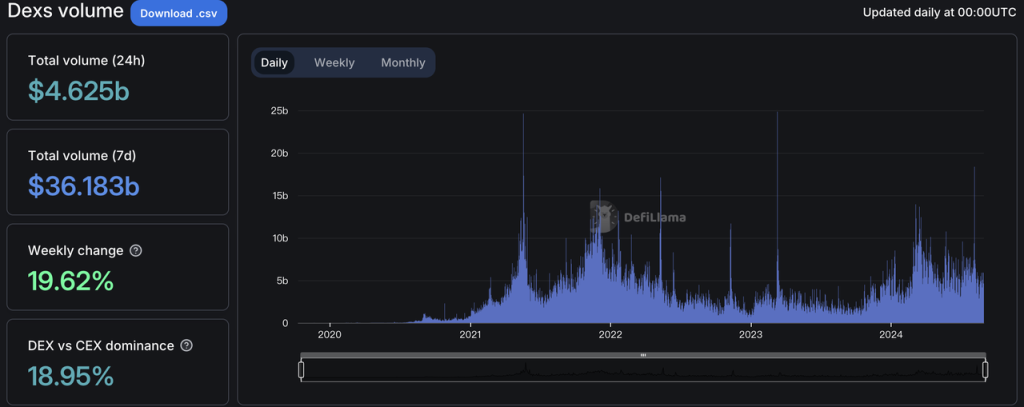
Market participants effectively vote with their wallets, and the blockchain, which offers “greater freedom and more affordable trust” (as discussed in “How to Invest in Web3 with its Fundamental Value“), is continuously proving its potential as a robust infrastructure for a broad spectrum of commercial activities.
Despite its impressive expansion, the blockchain space is in an early phase, with less than seven years in formation and less than four in genuine business operations. Signs of its emergent nature are evident, such as when the leading blockchain, Solana, experienced a 30-hour downtime in February this year. Furthermore, mainstream blockchain wallets still require that users maintain backups of lengthy seed phrases or private keys. Additionally, on-chain applications on the blockchain that have sustainable business models currently focus primarily on crypto-native assets, the integration of purely off-chain businesses with blockchain still needs to be explored.
In recent years, smart contract blockchains like Ethereum and Solana have seen significant growth in market value and expanded their capabilities to support a wide range of business activities. Regarding the resolution of “Availability” issues, there is now a clear strategy and achievable roadmap: Ethereum has adopted a strategy focused on scalability and efficiency, embracing Rollups and evolving towards a modular framework, with Layer2 solutions like Arbitrum and Base thriving, and a proliferation of dedicated layer2 and layer3 appchains. Conversely, Solana has pursued a different path, focusing on maximizing performance on a single chain, with an average TPS (transactions per second) exceeding 2,000, and a steady influx of new users and assets.
However, the “usability” of blockchain remains a significant challenge. The current on-chain experience, although adequate for the few million daily active addresses (with actual active users being fewer), is not yet capable of supporting the onboarding of hundreds of millions or even billions of individuals. To achieve “massive adoption” of blockchain, a transformative improvement in user experience is imperative.
In July 2023, Paradigm introduced the “intent-centric” concept, enhancing the Web3 user experience with what is now known as the Intent Network.
In simple terms, “intent” refers to a user’s specific need or goal. For example, if someone wants to “buy $1000 $BRETT (a memecoin),” this statement outlines their intent. Realizing this intent typically requires multiple transactions, especially when additional constraints lead to an increased number of transactions associated with fulfilling one intent.
In the given example, if my holdings of stablecoins are insufficient on the Base chain and are primarily on the Ethereum network, fulfilling the stated intent would involve the following steps:
Consider a scenario where a user needs to execute the intent of buying $BRETT but lacks the necessary stablecoins on the Base chain, with their funds primarily in Ethereum. The steps to fulfill this intent would include:
- Convert 1005 USDC into ETH on the Ethereum mainnet, because USDC cannot be used as gas fee on Base.
- Bridge $ETH from Ethereum to Base.
- Swap $ETH to $BRETT.
Executing these three steps demands a substantial amount of underlying knowledge. For example, consider the steps needed to buy Meme Coin $BRETT: First, I must identify and select the most efficient and cost-effective bridge between Ethereum and Base for transferring assets. Second, I need to find the Base chain’s RPC details and learn to add Base network to my wallet. Furthermore, it’s essential to know whether there is an effective trading aggregator on Base chain to secure the best pricing. If not, I need to identify which decentralized exchange primarily supports liquidity for $BRETT. For veterans accustomed to on-chain operations, these tasks may seem straightforward due to their familiarity and experience. However, for beginners, this process can be quite challenging. They often need detailed tutorials to work through each step of the process methodically.
In many ways, today’s on-chain experience mirrors the user interactions with computers before Windows 95 was introduced. Back then, computers were powerful tools capable of complex computations and sophisticated file management, yet they primarily operated through the CMD command prompt. This interface was highly efficient for those well-versed in computer logic and experienced in command-line operations—a preference that persists among many technology enthusiasts to this day. However, for most newcomers, this mode of interaction was overwhelmingly complex, often described as a “nightmare.” To navigate these systems, users were typically provided with a hefty manual, which was essential for mastering the various operations required to effectively use their computers.
However, the situation changed completely with the release of the Windows 95 operating system in 1995. Upon startup, computers directly entered a graphical user interface (GUI), where users could execute tasks with simple mouse clicks. The emergence of browsers also reduced the complexity of accessing the internet. For some, the shift from command-line to graphical user interfaces was seen as a minor enhancement in user experience; the graphical interface was merely a user-friendly packaging of underlying command-line operations. Unlike hardware advancements such as faster processors, which improved performance, Windows 95 made technology truly accessible to the masses. It lowered the barriers for average users, driving the widespread adoption of personal computers. Increased sales of personal computers led to reductions in the cost of Intel CPUs, which in turn enhanced both the performance and experience of PCs. This development triggered a “stepping effect,” where progress in one area spurred advancements in another, boosting global computer and internet penetration and setting the stage for the Internet Boom.
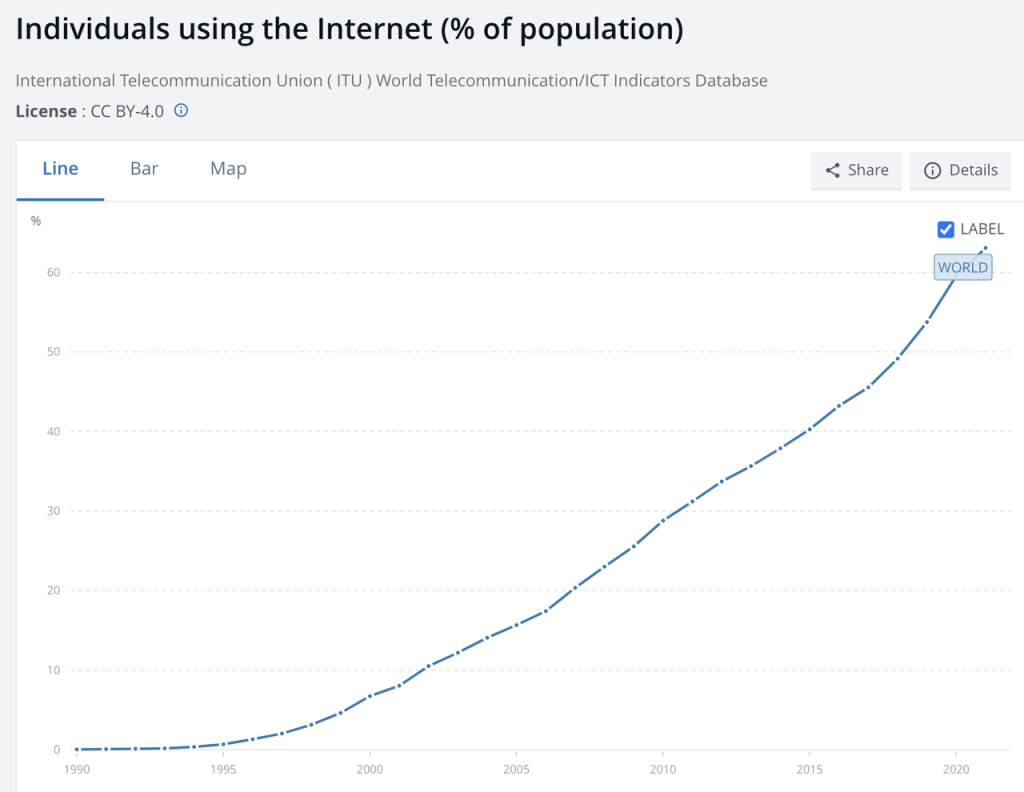
Looking back, it’s clear that what seemed like a modest improvement fundamentally transformed everyday life for individuals and propelled companies like Microsoft, Apple, Google, and NVIDIA to greatness over the last thirty years. This pivotal change is often celebrated as the “1995 moment” in the evolution of personal computers and the internet, a phrase that marks the beginning of a technological explosion.
Despite the smooth approval of the Bitcoin ETF, which gained positive governmental recognition for the cryptocurrency industry and attracted a lot of new users, most people still only hold their cryptocurrencies on centralized exchanges, using blockchain technology merely for basic transactions. Considering the adoption of on-chain applications, the “1995 moment” for cryptocurrency has yet to arrive. It may wait for a game-changing application or operating system tailored for end-users. Projects within the Intent concept stand a good chance of bringing about this pivotal moment.
Intent: The Best AI+Crypto Use Case
AI has advanced swiftly in recent years, with many believing that 2023 will be the “1995 moment” for AI, as ChatGPT and other chatbots powered by large language models have started to become a part of everyday life, and both the capital market and the general public’s attention to AI reaches an all-time high. The improvement of large language modeling capabilities is still far from seeing a bottleneck, leaving us uncertain about the limits of AI’s capabilities and its potential impacts. Furthermore, with the launch of GPT-4o, it seems the arrival of AI in our daily lives has been significantly accelerated.
The integration with AI has been one of the significant topics within the cryptocurrency space over the past year, with related concept tokens experiencing a price surge. From a commercial standpoint, blockchain-based AI agents represent one of the most potent use cases for AI + Crypto and this will make it possible to realize intentions more easily.
This is because the rules on the blockchain are determined, with clear boundaries and no black boxes.
As said in our report in April 2024, AI thrives within blockchain systems, fundamentally because the rules of the crypto economy are explicitly defined, and the system allows for permissionlessness. Operating under clear guidelines significantly reduces the risks tied to AI’s inherent stochasticity. For example, AI’s dominance over humans in chess and video games stems from the fact that these environments are closed sandboxes with straightforward rules. Conversely, advancements in autonomous driving have been more gradual. The open-world challenges are more complex, and our tolerance for AI’s unpredictable problem-solving in such scenarios is markedly lower.
In this case, as long as there is enough information input, AI will “identify the optimal solution more quickly than humans” in solving specific problems, thus helping people realize their intentions more easily and quickly.
An Analysis of dappOS
Business Overview
dappOS is an intent execution network, that simplifies the way users interact with decentralized applications (dApps) and public blockchains. Here’s how it works: Users simply communicate their desires—such as wanting to “buy $1000 worth of $BRETT”—directly to dappOS. From there, dappOS takes over, managing all the necessary interactions with various dApps and public blockchains to execute the transactions required to fulfill the user’s intent.
The ambition behind the name dappOS is clear—they aim to become the operating system for dAPPs, much like Windows 95 did for personal computers.
dappOS has established an open dual-marketplace within its ecosystem. On the demand side are the developers who create user-facing applications, and on the supply side are the service nodes that execute these user intents. To maintain a high standard of service, dappOS utilizes an Optimistic Minimum Staking (OMS) mechanism.
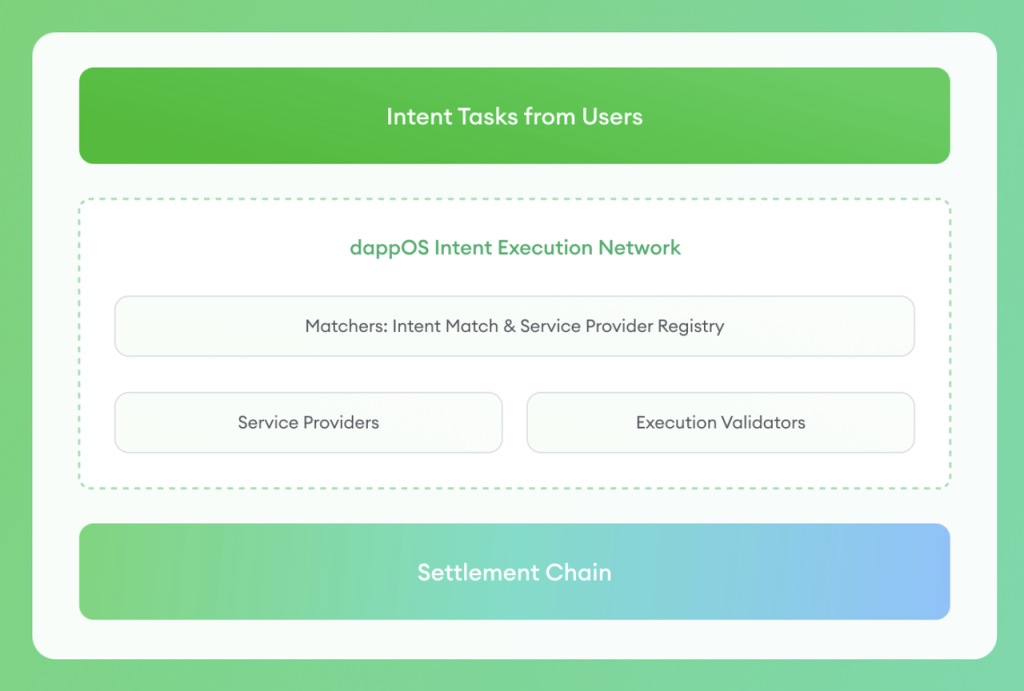
Key roles and their functions within the dappOS ecosystem are defined as follows:
- Users: They publish intent tasks based on the framework provided by dappOS.
- Service Providers: These entities execute the intent services. After depositing a specific amount of dappOS tokens as collateral, they can start accepting intents from users and generate revenue.
- Execution Validators: Tasked with overseeing the performance of service nodes. Validators have the authority to impose penalties on any service node that fails to fulfill its duties as required.
- Matchers: Responsible for matching users with suitable service providers
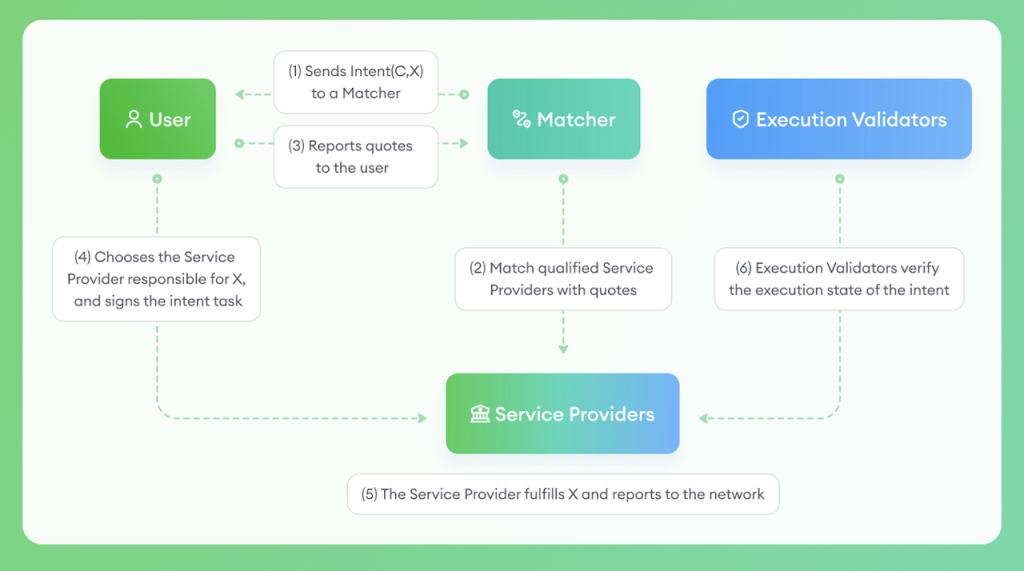
During the execution process, users interact with the system through a frontend interface to submit their intents to matchers. The matchers then approach the relevant service providers to gather quotes for these intents and present them to the users. If the users deem the quotes acceptable, they can select their preferred service provider to carry out the task. After making their selection, users will authorize the intent by signing it and transferring the necessary resources to the service provider, who then executes the intent as specified.
After the specified task duration, numerous validators verify whether the task has been successfully executed. If anyone identifies that the task was not completed, a challenge can be raised within the network. The validators will then use PoS voting to reach a consensus. If it is agreed that the task was not executed as required, the service provider is obligated to use their deposited collateral to compensate the user.
In addition to its core functionalities, dappOS implements an Optimistic Minimum Staking (OMS) mechanism. This approach requires service nodes to stake an amount slightly above the total value of the intents they are tasked with, enabling them to provide services with financial commitment (minimal). It also permits service nodes to continue executing tasks before verification (optimistic). If the service outcomes are validated successfully by the validators, the service nodes are entitled to their revenue from the tasks. However, if a task is found to be unsuccessful, the system imposes penalties on the service nodes, and the users are compensated as previously agreed.
The OMS mechanism aims to strike a balance between task efficiency, capital efficiency, and overall system security. Its goal is to ensure that user tasks are completed successfully while reducing the financial burden on service providers as much as possible. Additionally, through the intent execution network, ordinary users can benefit from the cost and efficiency of execution that professional service organizations provide. For instance, professional service providers have access to unique channels such as VIP accounts on exchanges with very low fees, the ability to aggregate multiple transactions to conserve gas, and superior capabilities for combating MEV on the blockchain. Moreover, competitive dynamics among service providers ensure that service costs are driven down to the most favorable levels, directly benefiting users. The dappOS intent execution network enables even ordinary users to enjoy the same level of service quality and cost-effectiveness that large institutions do.
dappOS currently provides three distinct intent frameworks:
- Intent Trading: This framework is tailored to optimize spot trading by helping users secure the most favorable costs.
- Intent Assets: Within the dappOS ecosystem, this framework treats a series of equivalent assets in a fungible way, addressing the yield-generating and trading properties of the assets.
- Intent-based dAPP Interaction: This framework serves as a practical tool for specific activities, like the “buying $1000 $BRETT” example. It streamlines the process of interfacing with dAPPs and efficiently facilitates asset bridging.
The Intent Assets framework smooths out the variations between different blockchains and different fungible assets, thus eliminating much of the work involved in cross-chain or fungible asset exchanges and enhancing user experience. We will take stablecoins and $ETH, which are currently the most universally utilized crypto assets, as examples.
- In the case of stablecoins, users have the option to deposit USDT or USDC from any blockchain into their dappOS account to mint intentUSD. Once minted, intentUSD can be invested in various stablecoin projects that generate interest automatically, with the liquidity of funds transparent and visible to the user, ensuring both earnings and transparency. This setup also simplifies transactions: for instance, when users wish to transfer USDT into a centralized exchange, they can directly use intentUSD. Similarly, if users need to deposit USDC into GMX as collateral, they can conveniently withdraw intentUSD for this purpose.
- In the case of $ETH, when users convert their deposits into intentETH, it similarly begins to accrue interest automatically. Additionally, intentETH grants the flexibility to purchase assets across any blockchain. For instance, users can readily swap intentETH to $QUICK on the Polygon network, or $JOE on the Avalanche network. Similarly, intentETH can be deposited into Aave on the Arbitrum chain for lending or borrowing services, or as gas on the Ethereum and Layer2 networks, depending on user demand.
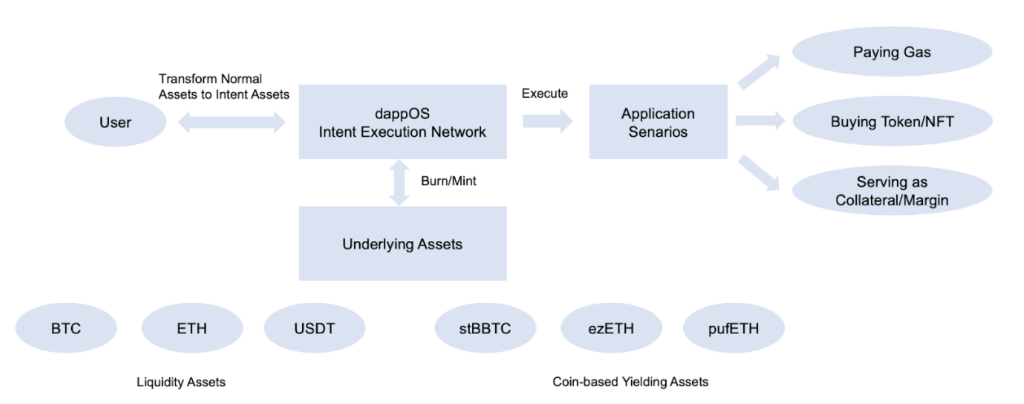
It’s clear that intent assets have advantages:
- It strikes a balance between profitability and convenience. For instance, while sDAI provides stable returns from real-world assets (RWAs), its liquidity is insufficient for large transactions. Conversely, commonly used assets like USDT and USDC, despite their widespread adoption, do not accrue earnings. intentUSD effectively bridges these gaps, offering both liquidity and returns.
- They eliminate the slippage between similar assets. For example, intentETH allows for a cost-free bridge among ETH on mainnet, ETH on Arbitrum, stETH, and aETH.
Intent assets also demonstrate advantages over other traditional yield-bearing assets:
- LST or LRT Assets: Unlike these assets, intentETH doesn’t need to be locked up, thus providing better liquidity.
- sDAI or RWA-based Stablecoins: Unlike these stablecoins, intentUSD is always available for trading.
- Flexible Earn Products on Centralized Exchanges: Intent assets can be easily used across dApps.
- Lending Protocols and DeFi Yield Platforms: Intent assets offer the unique capability to move seamlessly across blockchains, available for immediate use in trading.
Overall, the experience offered by Intent Assets closely mirrors services like money market fund products, providing an excellent experience with a new trade-off between the profitability, usability, and convenience of assets.
Enhanced user experiences are important in onboarding hundreds of millions, perhaps even billions, of users to the crypto economy. The crypto economy is still in its early stages and as pioneers, we have grown accustomed to using multiple stablecoins, such as USDT and USDC, and can efficiently exchange between them at minimal costs, choosing the right asset for different situations. However, in the physical world, no one thinks we should accept “JPMorgan dollars” and “Citibank dollars” simultaneously, despite their close similarities. For newcomers to the crypto economy, grasping technical details such as “the differences between L1 and L2” or “how to execute cross-chain transactions” might not be necessary, much like how most people are unaware of the intricacies of interbank clearing systems. They simply require a more straightforward method to meet their needs. Bridging this gap in user experience is precisely the goal of Intent execution projects.
Business Partnership
dappOS operates with a unique business model that heavily relies on collaborative efforts with other dAPPs. dappOS has successfully forged partnerships with a wide array of dAPPs.
In January 2023, dappOS formed a partnership with the perpetual platform GMX. As part of this collaboration, dappOS launched a specialized website, gmx.dappOS.com. This integration allows GMX users to streamline their trading operations directly through dappOS. Key benefits of this partnership include a substantial 20% reduction in trading costs and the added convenience of paying gas fees with any token. During the first quarter of 2024, weekly active users peaked at over 6,000, and more recently, the figure has consistently been around 1,000. The platform also achieved a trading volume of nearly $150 million, with daily trading highs of over $10 million.
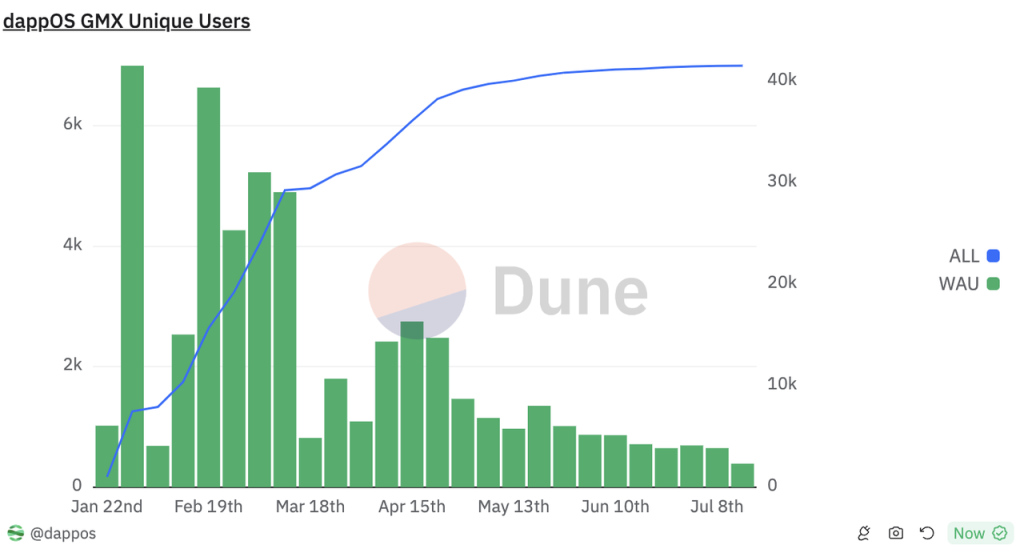
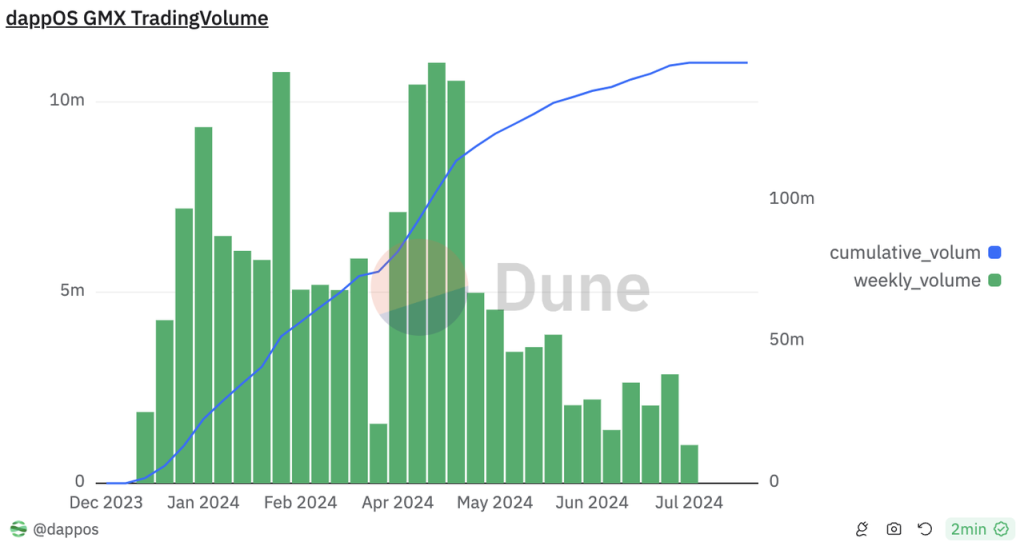
dappOS has established partnerships with Kyberswap, a dex, and Benqi, a lending protocol on the Avalanche network. These collaborations have resulted in substantial engagement, with dappOS weekly unique users registered via Kyberswap over 3,000 and Benqi maintaining around 1,000.
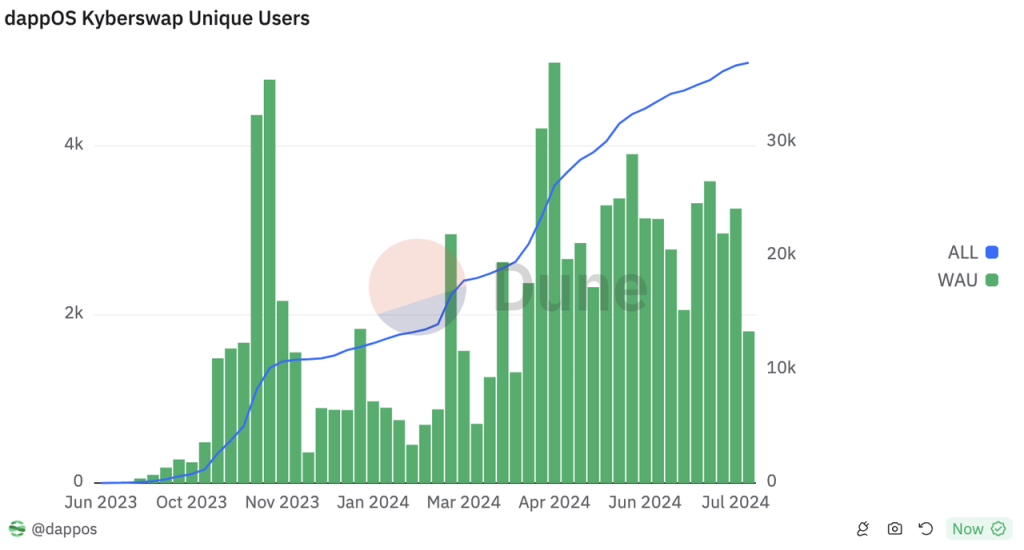
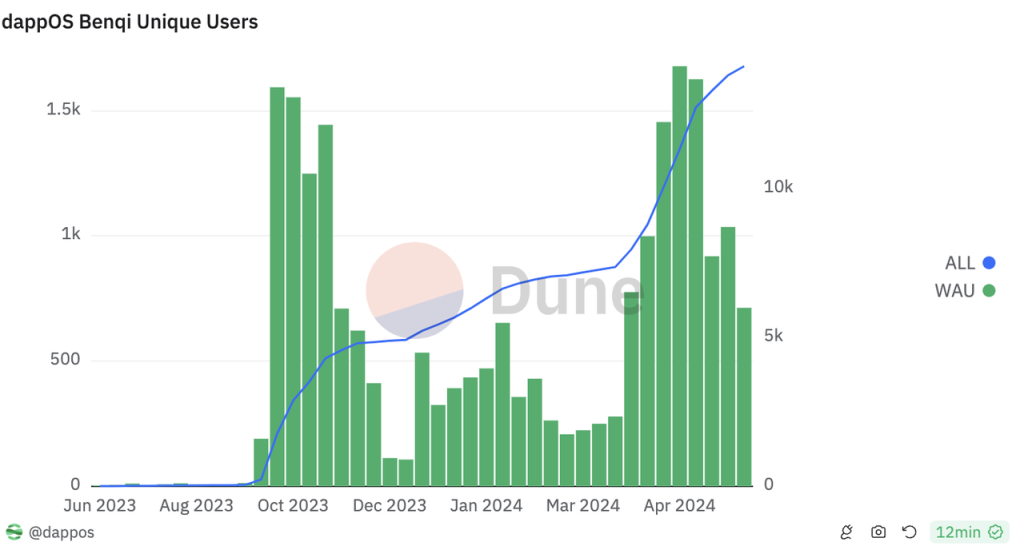
Moreover, dappOS has also forged partnerships with major public blockchains including Avalanche, zkSync, and Polygon, alongside collaborations with DeFi protocols such as Quickswap, MakerDAO, and Frax.

Financing Backgroud
dappOS has completed three funding rounds.
It was selected for the fifth season of the Binance Labs Incubation Program in November 2022, and subsequently secured Pre-Seed funding from Binance Labs on June 20, 2023. The details of the funding amount, however, have not been publicly disclosed.
On July 21, 2023, dappOS closed its seed funding round at a valuation of $50 million. This round was led by IDG Capital and Sequoia China. Other notable participants included OKX Ventures, HashKey Capital, KuCoin Ventures, TronDao, Gate Labs, Taihill Ventures, Symbolic Capital, Foresight Ventures, BlueRun Ventures, Mirana Ventures, Leland Ventures, among others.
On March 28, 2024, dappOS finalized its Series A funding round, raising $15.3 million at a valuation of $300 million. Polychain led this round, with participation from Nomad Capital, IDG, Flow Traders, IOBC, NGC, Amber Group, Uphonest, Taihill, Waterdrip, Bing Ventures, Metalpha, Spark Digital Capital, Web3Port Foundation, and Satoshi Lab, among other participants.
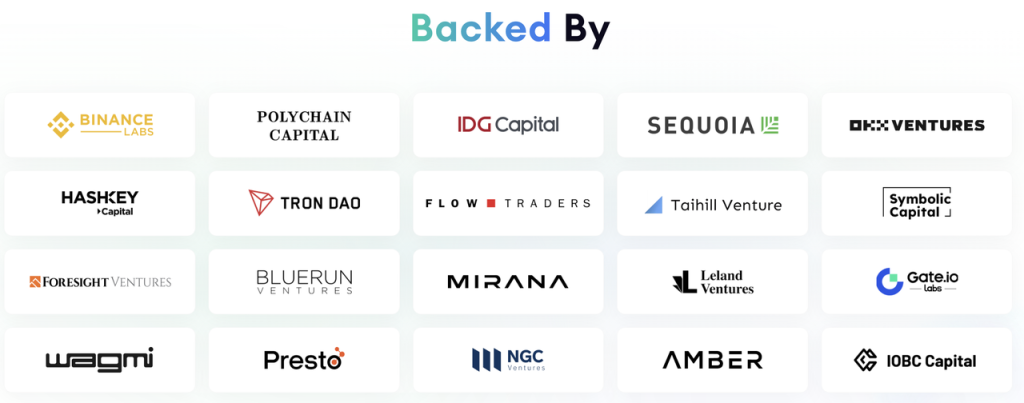
Overall, dappOS has a robust investment background and has recently finished a well-funded $15.3 million funding round.
Summary
The Intent execution project is focused on improving the user experience in the Web3 industry, aiming to catalyze Web3’s “1995 moment” and foster massive adoption. Over the past year, it has also emerged as a popular trend for venture capital investment, with many projects converging around the concept of intent.
However, the intent execution network is still budding, with most projects lacking gp-to-market products and clear business models. Specifically, the majority of products and mechanisms associated with dappOS, as discussed in this article, are yet to be launched. Consequently, there remains considerable uncertainty about the future trajectory of both the track and the projects within it.
For projects that may lack short-term deliverables but possess substantial potential for long-term value, two critical indicators stand out: the quality of investment backing and the capacity for commercial expansion.
dappOS is supported by a lot of famous investors, including top exchanges, traditional venture capitalists, and crypto VCs, showcasing an impressive roster of backers. Moreover, its successful partnerships with notable DeFi projects like GMX highlight dappOS’s robust commercial capabilities.
As dappOS continues to develop and expand its role in leading the Intent Execution, we will maintain a close watch on its progress.



